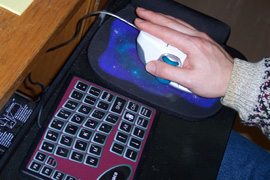Ergonomics Target Workplace Strain, Pain
 |
| Steve Windsor, database administrator, suffers from repetitive strain injury and uses special ergonomic tools at work such as rubber-ball chair, a specially designed mouse, a headset and a touch-sensitive keyboard. |
| Posted 01/17/06 |
 Working on a computer all day can become a real pain in the neck (and the back and forearms and hands). Fortunately, a new ergonomics Web site created by Information Technology Services has several suggestions to keep bodies in balance. Working on a computer all day can become a real pain in the neck (and the back and forearms and hands). Fortunately, a new ergonomics Web site created by Information Technology Services has several suggestions to keep bodies in balance.
The site, http://www.wesleyan.edu/its/ergonomics/, offers advice on good working positions, stretches, workstation guidelines for health, an office ergonomics checklist and even the Occupational Safety & Health Administrations guidelines for proper video display viewing. Ergonomics is the science that studies the relationship of humans to their working environment and seeks to improve working conditions and increase efficiency. Proper ergonomics can prevent repetitive strain injury, explains Steve Windsor, database administrator. Repetitive strain injuries are a subtle affliction which may develop undetected for months or years before it is noticed by the user, Windsor says. Correspondingly, it may take the same amount of time for the user to completely heal. Windsor knows about work-related physical stress first hand. Ten years ago, the then-corporate programmer noticed tightness in his neck and shoulders and pain in his arms and wrists. He tried to ignore the pain for several months, but by the time he saw a doctor and was prescribed physical therapy, it was too late. For six months, he was unable to type, and any forms of gripping jars, door handles, steering wheel and even shaking hands became too painful to bear. Windsor lost his job as a result. In 1997, Windsor came to Wesleyan where they were very receptive and supportive of my condition, he explains. Windsor currently goes to physical therapy sessions in combination with anti-inflammatory drugs and nutritive supplements. At work, he uses a rubber-ball chair to align his spine, a specially designed mouse, a headset that he can use to dictate text rather than type it, and a touch-sensitive keyboard that eliminates the need to push keys. Several body-aligning illustrations are depicted on Wesleyans ergonomics Web site. The site suggests simple stretches, such as a head rotation, lateral neck stretch, finger flexor stretch, standing back bend and arm stretch. Each stretch should be performed throughout the workday, explains Brandi Hood, senior project coordinator for Physical Plant and ergonomics expert. Hood makes formal assessment of Wesleyan employees workstations. Windsor says when an employee is diagnosed with a repetitive strain injury a typical reaction is to throw ergonomic equipment at the problem. However, the employee’s posture and work habits are the most important issues to study for a correct diagnosis. All the ergonomic equipment in the world will not affect positive change unless the user addresses postural and working habits, says Windsor. When setting up a computer workstation, Hood suggests that employees should be aware of neutral body positioning. This is a comfortable working posture in which joins are naturally aligned. This reduced stress and strain on the muscles, tendons and skeletal system. Proper posture and limb alignment include making sure your feet are flat on the floor, your butt is all the way back in the chair, your back is in contact with the back of the chair, and your arms are relaxed close to your sides to reduce the severe angles between your shoulder and elbow and your elbow and wrists, she says. These postures are illustrated on the ergonomics site. This year, Hood and Julia Hicks, associate director of Human Resources, are planning at least one ergonomics session for Wesleyan employees. |
| By Olivia Drake, Wesleyan Connection editor |

